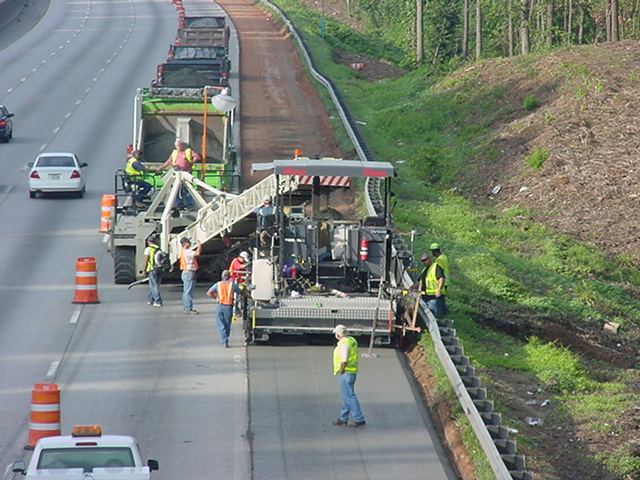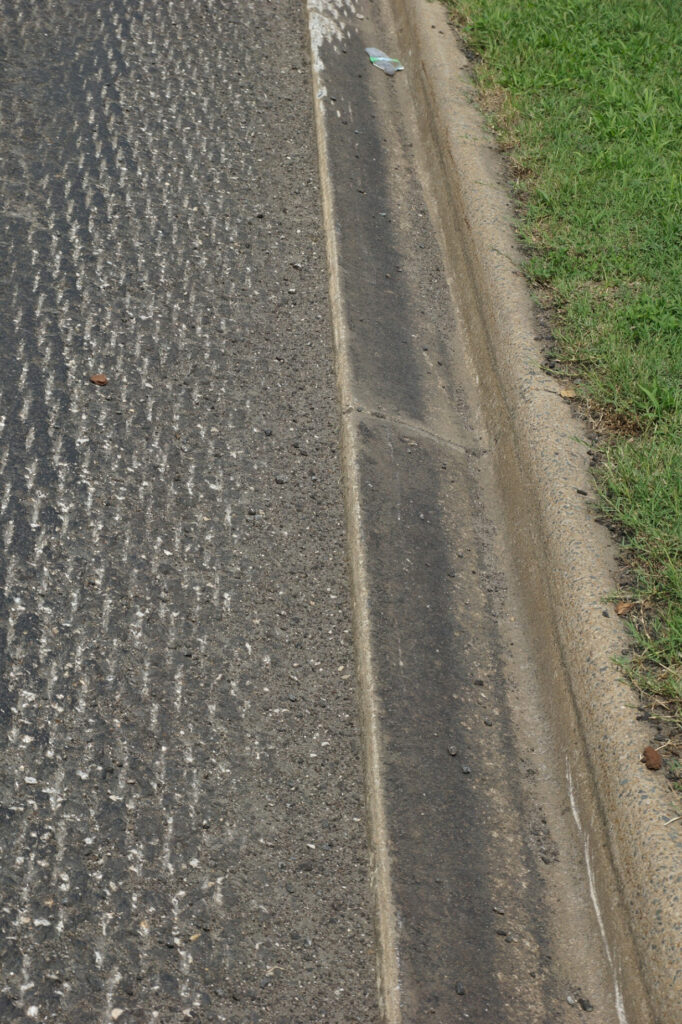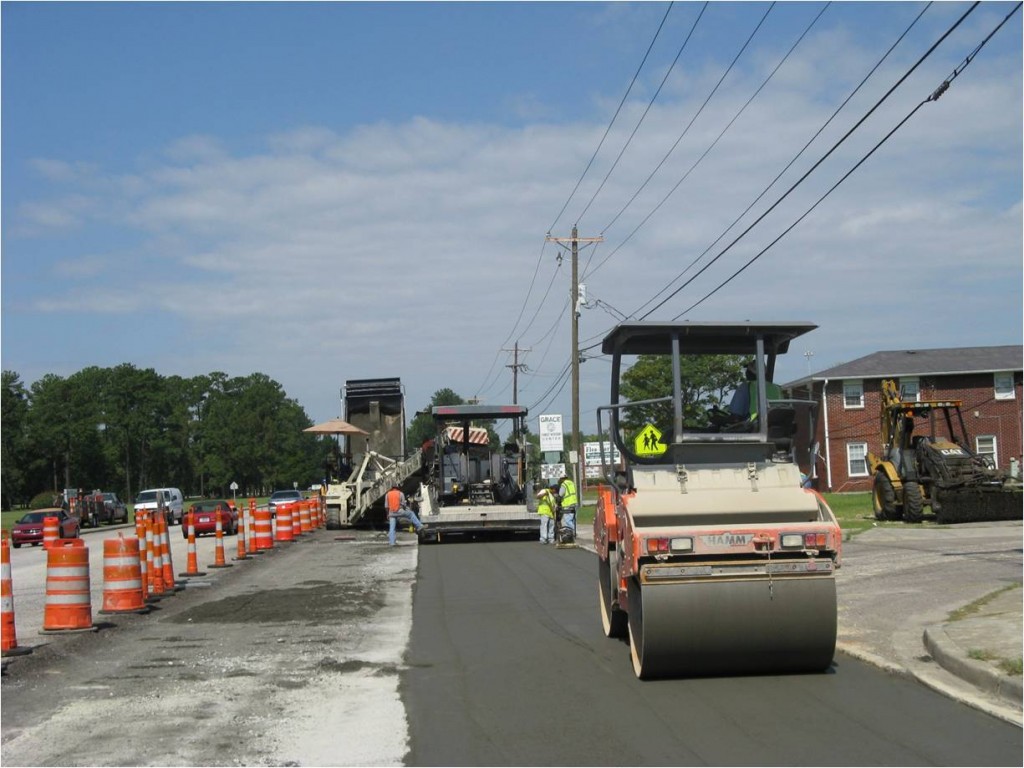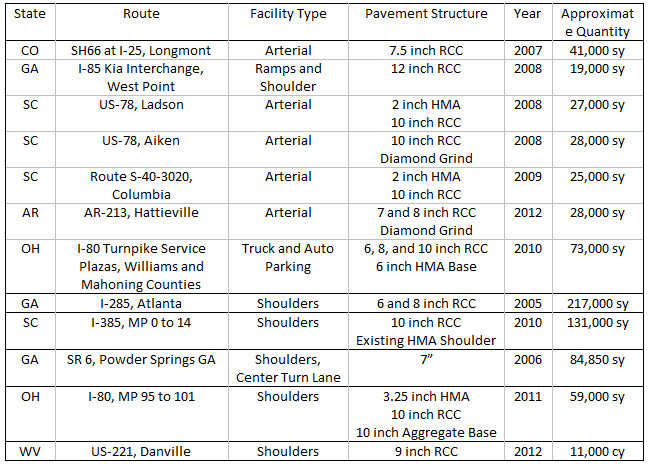Andrew Johnson, PhD, PE, Pavement Design | Engineer, Portland Cement Association – Southeast Region
With tight budgets and fluctuating commodity prices, state and local highway agencies are turning more and more to Roller Compacted Concrete (RCC) pavement as a paving alternative. RCC is ideal for situations where high strength, rapid construction, and long-lasting durability are desired at an economical price. RCC’s virtues have been well-proven in industrial applications, but evolving technology and experience are making RCC feasible for many paving applications where other materials have traditionally been used.
RCC Background

State transportation agencies use RCC for shoulders, one of the most common uses, where low cost alternatives are necessary.
First developed in Canada for use in log-skidding yards in the 1970s, RCC is often referred to as “negative slump” concrete. Unlike traditional concrete, which is relatively liquid and can be consolidated through internal vibration, RCC has a much lower water-cement ratio and must be compacted to attain its design strength. Once compacted, RCC can develop very high strength; 28-day compressive strengths in excess of 6000 psi are common in many applications. High early strength is also possible with compressive strengths of 2000 psi being developed in less than 24 hours.
While development of compressive strengths comparable to traditional high-performance concrete is a key feature of RCC, one of its unique aspects is its ability to carry limited loads immediately after placement. Because it is compacted, RCC has the ability to transmit loads as a granular solid prior to the hydration of the Portland cement. This feature allows cars and trucks to cross the RCC literally minutes after it is placed, instead of the hours needed for traditional fast-track concrete. Consequently, the use of RCC can allow for minimal service disruption to residences and commercial businesses.
RCC is generally placed with a high density paving machine. Although very similar in operation to conventional asphalt pavers, high density pavers have tamper bars and other systems that are capable of producing 90 percent modified Proctor compaction or higher in RCC lifts as thick as 9 inches at the back of the paver. Several states use the requirement of 90 percent compaction immediately behind the paver as a performance requirement to define a high-density paver.
The RCC material itself may be manufactured in a variety of ways. Depending on the application, the RCC may be produced by a ready-mix concrete supplier, in a portable central mix batch plant used for conventional concrete paving, or in a continuous pug mill operation. Because the placement of RCC resembles hot mix asphalt in some ways, RCC mix aggregate gradations are generally similar to asphalt gradations.
State Transportation Agency Usage
The use of RCC has grown rapidly with state transportation agencies over the past ten years. Shoulders, industrial access, turn lanes, rest areas, and even state highways have been paved with RCC across the Southeast and Midwest United States. A brief list of state agency RCC projects is shown in Table 1. This is by no means a comprehensive list, but illustrates the range of projects being built.
For state transportation agencies, one of the most common uses of RCC is for shoulders. Georgia, Indiana, Louisiana, Ohio, Pennsylvania, South Carolina, Tennessee, and West Virginia have all used RCC for shoulders. These applications have shown RCC to be a low cost alternative where the shoulders do not have to be tied to the mainline for support. Arkansas, Colorado, Georgia, Kansas, Missouri, and South Carolina have also used RCC for roadway paving on multiple projects, some of which has been capped with a layer of asphalt while others use diamond-ground or untreated surfaces.
South Carolina in particular has been a frequent user of RCC for urban reconstruction in areas of high truck traffic, having let over 20 projects in the last five years. Between shoulder and reconstruction projects, SCDOT has built approximately 700,000 square yards of RCC since 2008.
Most of South Carolina’s urban reconstruction projects involved four- or five-lane curb and gutter sections that were highly deteriorated. Significant overlay of these sections was unacceptable because of the fixed gutter elevations; many of the projects had two to four inches of asphalt over the original gutter already. So, a simple overlay could not be performed due to grade constraints and structural considerations.
SCDOT chose RCC to solve their dilemma. These projects typically proceed as follows. The first step is to mill the asphalt on the entire project to an elevation that is two inches below the gutter. (Figure 1.) Next, the existing pavement is milled an additional eight inches in one lane only. (Figure 2.) Immediately following the second milling operation, RCC is placed in the deep milled area back to the elevation of the adjacent lane. (Figure 3.) Although mainline traffic is not typically allowed on the RCC until the next day, traffic is allowed to cross the RCC immediately, if necessary, to restore access to property owners along the road. Transverse contraction joints are cut using an early entry saw as soon as compaction is complete. Finally, once all the travel lanes have been replaced with RCC, the entire project is capped with a layer of asphalt to provide a uniform surface and restore the gutter. However, because the RCC is only two inches below the gutter, final overlay of the RCC can be delayed for several weeks.
Problems Encountered
For all its benefits, RCC does currently have some limitations. Because of the way it is placed, it is not possible to insert dowels or tie bars in the joints. When RCC is used in urban settings where material delivery may not be ideal, achieving a satisfactory ride may be problematic. However, SCDOT has built two projects where the RCC was the final riding surface. In these projects, the RCC was successfully diamond ground and final rideability met SCDOT requirements for interstate concrete. Also, problems have been encountered at construction joints due to poor compaction; this problem has been minimized through careful construction technique.
However, the most prominent issue for RCC has been surface texture. Unlike conventional concrete, RCC cannot be finished using floats and trowels. Instead, under ideal circumstances RCC has a texture that resembles asphalt. But, RCC mixes often have pockets of coarse material or very shallow tension cracks that resemble “tender” asphalt. Also, on SCDOT projects where mainline traffic was placed very promptly on the RCC, scaling of the surface has been encountered after two to three days, although the underlying RCC was sound. For these reasons, South Carolina and other agencies have elected to cap some of their RCC projects with an asphalt wearing course.
A common denominator among the projects shown in Table 1 and most successful RCC projects is the use of a high-density paver. Although conventional asphalt pavers have been used to place RCC with mixed outcomes, the greater thicknesses of normal RCC courses demand the use of special equipment for consistently satisfactory results. Although once exotic, high density pavers have become more widely available, making the use of conventional pavers undesirable. It is strongly recommended that high-density pavers be used for future projects.
Future Developments
Great strides have been made in RCC surface texture in the last few years. Better mix designs, improved construction techniques, and more experienced contractors have resulted in improved ride and surface textures on recent projects. As the product continues to improve, RCC is poised to be a game-changing material for the paving industry.
Andy Johnson can be reached at (803)556-2889 or at [email protected]



